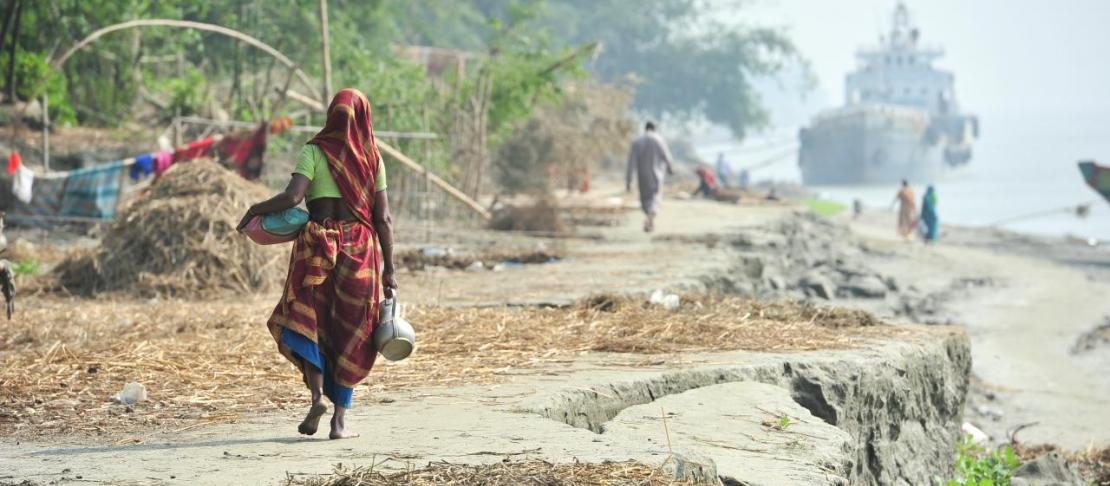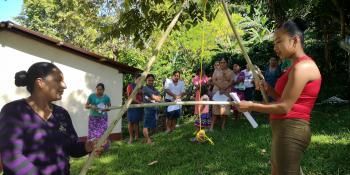Underground Taming of Floods for Irrigation: gendered impacts of intervention

Researchers assess the gendered perceptions of technology impact
Underground Taming of Floods for Irrigation (UTFI) is a new technology that is being piloted in Jiwai Jadid village of Ramganga sub-basin in Uttar Pradesh. This new technology involves diverting high water flows from rivers or canals when prone to flood risk and recharging the groundwater via village ponds or small dams that are modified for this purpose. By design the technology is gender neutral and is expected to benefit both men and women by offering them greater convenience, better health and enhanced socio-economic opportunities through improved water facilities. But the extent to which the communities benefit from such interventions and aid in its sustainability remains sensitive to the socio-cultural context and the institutional frameworks under which they are executed.
Impact study
An impact study supported by the CGIAR Research Program on Climate Change, Agriculture and Food Security (CCAFS) was undertaken by researchers from the Energy and Resources Institute, to analyse the gender response to the UTFI pilot in Uttar Pradesh. For this, qualitative methods were chiefly employed to gather information from various stakeholders. The methods used were as follows:
- Focus group discussions (FGDs) with three types of groups: Women, Men and Panchayat members. FGDs were conducted separately with groups of men and women. The aim of the discussion with women’s group was to analyse the impact of the intervention on domestic use of water, whereas with the men’s group it was mainly to assess the impact on agriculture production and productivity. The discussions with Panchayat members helped to understand other impacts of the technology and issues related to ownership and sustainability.
- Semi-structured interviews [Key person interviews (KPIs)]: UTFI caretakers, School teachers and Shop keepers. KPI was conducted to elicit detailed information about the impact of the intervention and to explore specific challenges if any, related to operation, maintenance, ownership and sustainability.
Gendered face of technology
In the otherwise small sleepy village of Jiwai Jadid, the women folk are amused by the introduction of the new ground water recharging technology. Sunita Yadav, a home maker who resides close to the UTFI structures thoughtfully acknowledged that “the hand pumps at my house yield more water especially during winter months”. Pushpa, her neighbour couldn’t agree more. She further added that “now with this new technology in our village, less time and effort is required to fetch water from the hand pump”. Similarly, post UTFI intervention, the farmers in the village experienced increased availability of water especially in the months ranging from July to February, although they did not observe any marked difference in the productivity of agricultural yields.
The village elders also recounted other benefits like availability of fresh leafy vegetables that are planted along the boundaries of the structures. Ram Prasad, an energetic octogenarian remarked: “the biggest benefit has been the general cleanliness in the area, prior to the intervention the area near the UTFI structures used to be dumping ground for the village garbage”.
The research study which explores the gender and social dimensions of the technology clearly revealed that there is a perceived benefit of the intervention by both men and women in terms of improved water availability for both domestic and agricultural purposes and other benefits that go beyond the prescribed mandate of the technology.
Factors influencing ownership
The village which exhibited a high degree of social cohesion is still strongly governed by stringent social and cultural norms. Women from the upper castes are not active in the public domain and their participation in local institutions such as panchayats is still not approved by the men in the community.
Hence, despite the perceived benefits of an intervention like UTFI, keeping the interest of the community and especially of the women folk in operating and maintaining the structures becomes a challenge. Sujatha, a home maker from the Thakur community remarked: “to tell you the truth women in our village will not be able to undertake the responsibility of the structures as it will involve maintenance and collection of charges which women are not comfortable doing”. She further added, “technology is the preserve of the male”.
The men also reinforced such stereotypical beliefs that women will not be in a position to maintain the structures. Such perceptions of the community, which is shaped by deeply-held beliefs about gender roles, has only added dynamics to a technology that is designed to tackle the dual challenges of floods and ground water depletion. However, Sujata, an active panchayat member favourably declared that “we are lucky to have this intervention in our village and we will work towards greater participation by all stakeholders including the women in the community to ensure its sustainability”.
Way forward
In order to ensure ownership and sustainability of the initiative, the project team is actively working with the village community to build awareness of the interventions, especially among the women folk. However, given the social structure and cultural barriers, it would be a challenge for the women folk to undertake responsibilities such as operation and maintenance of the system. Hence the project team is working in close coordination with the panchayat for the creation of management committees where some of their existing programs like MGNREGA can be dovetailed with the UTFI interventions.
Read more:
Mini Govindan is a Fellow at the Energy and Resources Institute.
This article has been edited by Shehnab Sahin, CCAFS South Asia Communications Specialist



